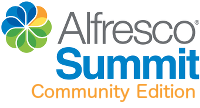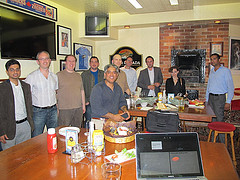 Pick a commercial open source software product that’s important to you. Now imagine that there’s been a global zombie attack. Fortunately, after much heroics and stylized cinematic violence, the attack is eventually thwarted. Unfortunately, it wasn’t soon enough. Everyone who receives a paycheck from the company behind your favorite commercial open source company is now a zombie in the steadfast pursuit of acquiring brains for food–they could care less about your sev one support ticket. The question is this: Can the open source software project survive without its commercial backer?
Pick a commercial open source software product that’s important to you. Now imagine that there’s been a global zombie attack. Fortunately, after much heroics and stylized cinematic violence, the attack is eventually thwarted. Unfortunately, it wasn’t soon enough. Everyone who receives a paycheck from the company behind your favorite commercial open source company is now a zombie in the steadfast pursuit of acquiring brains for food–they could care less about your sev one support ticket. The question is this: Can the open source software project survive without its commercial backer?
My blog readership consists of multiple audiences. For some of you, the question posed is interesting because your company depends on that software to run its business. For you, this is a “sole source supplier” problem with the primary concern being: If the software vendor goes away, is there another place I can get the same software?
Some of you are like me–you provide professional services around commercial open source software. The commercial company produces the software you deliver to your clients but may also provide other types of assistance such as marketing, business development, and training.
Still other readers might be classified as “community members” who give time and resources toward the project. Members of the first two groups are often members of this group as well. It is this group–the community–that becomes critical in answering this survivability question as we shall soon see.
Okay, so back to the scenario. Zombies attack. Zombies subdued. Sadly, all of the employees of our commercial open source software vendor are no more. Why is the question of survivability even a question? Remember, we are talking about open source software with a primary commercial backer. Your organic open source projects are safe from zombie attacks, for the most part, because there is no single company responsible for its development. For organic open source projects with a large, healthy community, the load of building and maintaining software is distributed across potentially hundreds or thousands of individuals employed by many different companies. Commercial open source, on the other hand, has a single company that pumps significant dollars into engineering, research and development, sales, and marketing. If that company goes away, there’s a clear risk to the project. Stakeholders need to understand this risk.
For the rest of this analysis, I’m going to ignore the very real investments commercial open source vendors make around marketing, business development, community management, and training. These things matter, of course, but they don’t matter at all unless you ship code. As the smoke clears from the zombie attack, the single most important thing facing the surviving stakeholders is getting out the next release.
Suppose our zombie-stricken company sold support for what was already an extremely successful open source project. There are many people who regularly make very significant contributions to the code base and documentation. There are lots of people answering questions in forums and on IRC. That healthy community means there is a viable population of non-zombies who will obviously mourn the loss of their former collaborators, but will no doubt bravely carry on.
Now, instead, imagine a commercial vendor who is really open source in license only–they lack a community entirely. There are exactly zero people outside of the company who know anything at all about where to get the code and how to build and test it, let alone the intricate details of how it works. It’s clear this project is doomed. Maybe someone would fork the code base and start a new company but that would be tough. Unlike what MariaDb did after the Oracle-MySQL acquisition, our scenario doesn’t allow a new company to bootstrap with experienced founders or engineers, at least those who were employed by the vendor at the time of the zombie attack.
From looking at these two extreme ends of the spectrum it is clear that the thing that allows the project to continue is the viability of the project as an independent open source project and that depends on the health and makeup of the community.
To answer this question–whether or not a commercial open source project could operate as an independent organic open source project–there are several aspects of the current community to assess:
Pre-commercial open source success. If the software project was a successful organic open source project before the commercial company appeared, this is a good indicator that if that company were to go away, the software project would survive.
Governance model. Is the software and associated trademarks under the control of an independent foundation? If so, that’s good–a lot of the details and processes will already be taken care of. Formal governance of this sort is designed around ensuring viability independent of a single commercial backer.
Number of external committers. How many committers are employed by the commercial company? If the answer is 100% that’s bad for survivability. In our scenario anyone working for the company is now a zombie which means there will be fewer experienced people to work on the next release.
Number of external contributions. What kind of contributions have typically come from the community? If it is low volume or mostly insignificant patches, this is another negative indicator. If the project stands a chance of survival post zombie attack it needs significant activity from independent contributors because that provides a population of people who are familiar with the technical details of the product.
Install base. A product installed in a large number of big companies would be ideal but even a few large “anchor” companies would be sufficient. The surviving community will need to pool its resources to move the project forward. If it is strategic to stakeholders with deep pockets, those stakeholders may be willing to invest in the software’s future.
Product complexity. The simpler, the better. When a product gets complex, its engineering team starts to specialize. A large community could do that too, but if the product is complex and the surviving community is too small, there may not be enough people who can go deep enough on every part of the system to maintain the entire thing. A complex product also requires more resources to test and build.
Upstream dependencies. If the product is a relatively thin veneer on a handful of well-known upstream dependencies, that’s good. It means you might be able to depend on some of those upstream communities for help. However if the system is complex and has a lot of smaller dependencies, it means the surviving community has a lot to learn and the upstream communities may lack the resources to be of much help.
Downstream dependencies. If the software is used by many other projects downstream, that’s a good thing because it significantly increases the number of people interested in keeping the project alive.
Company diaspora. How much turnover has there been over the life of this company’s engineering department? Low turnover means there will be fewer people in the market who know the deep dark secrets of the code base.
Community makeup. This is closely related to the “external contributions” aspect. If the community is mostly “power users” that’s a problem for survivability. What you need is a community that has a significant number of individuals who are passionate and technical enough to dedicate time and resources to moving the software forward. It obviously helps if the software is strategic to their employers.
You might assess your favorite commercial open source software and realize that it isn’t viable without commercial backing. That doesn’t mean it’s a bad company or a bad product. What it does mean depends on your perspective:
If you depend on the software for your business…
- And you are evaluating the software for purchase, you cannot give “availability of source code” a much higher score against other alternatives because one of the benefits you derive from that–the ability to continue forward should the company go away–is less likely to be realized. (see “Why Clients Choose Open Source”).
- And you already have the software installed, have a backup plan in mind should something happen to the vendor, just like you would a proprietary vendor. If you deem a major event to be likely, consider moving to an alternative now.
If you are part of the commercial open source software project’s community…
- Push for changes in the aspects identified above that would make the project more viable as an independent project. Realize, however, that not all vendors are enlightened (or empowered) enough to execute these changes.
- Be okay with the fact that you are dedicating time and energy to something that depends mostly (or entirely) on its commercial backing. This means not getting bent out of shape when the commercial company does something to further its commercial interests. Or don’t be okay with it and move on.
- Assess your zombie attack survivability as a community and identify initiatives that address areas of weakness.
If you are the commercial open source software vendor…
- Be careful how you market your open source-ness. If your software fails the zombie survivability test but you tout open source as a major advantage, your marketing message may ring flat.
- Be open to ideas that could give your software the ability to outlive you. This makes it more attractive to customers and community members alike. It makes your open source claim more genuine.
Obviously the specific threat of a zombie attack is far-fetched. But the risk of a commercial open source company being acquired, folding, or radically shifting their business model is quite real. Just because “commercial open source” has “open source” in it, does not magically give it a vibrant community that can fulfill the vital engineering and quality assurance role that the commercial company often provides. Even a vibrant community may lack the proper make-up to step in should it need to.
Regardless of which role you play, if you are a stakeholder in a commercial open source software product, it is important you assess this risk and have a plan should the need arise.

 Earlier this week, in a
Earlier this week, in a  The months leading up to
The months leading up to 
